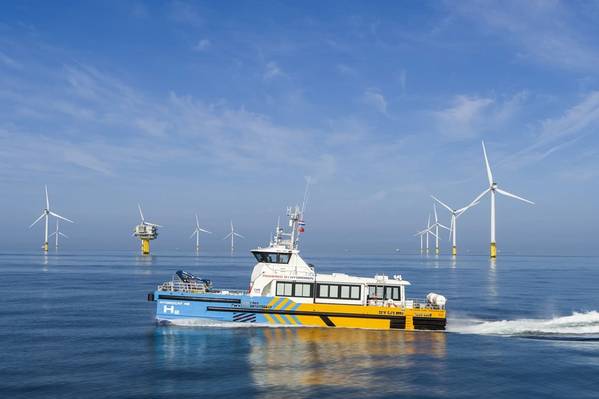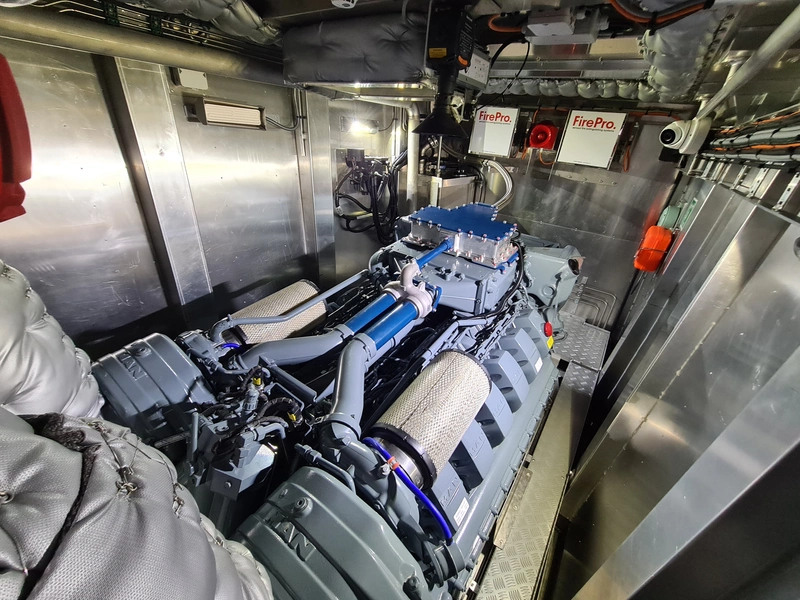
The world's first dual-fuel hydrogen- and diesel-powered crew transfer vessel (CTV) is ready for service, outfitted to run the cleaner fuel that reduces up to 80% of its traditional fuel usage and associated emissions.
The 25-meter vessel, Hydrocat 48—owned by Windcat Workboats, part of Compagnie Maritime Belge (CMB)—is based on the Windcat MK 3.5 design but lengthened to integrate adequate hydrogen storage on board. The vessel, which has been certified by Lloyd’s Register and U.K. Maritime and Coastguard Agency, recently completed bunkering and sea trials in May.
It is equipped with a pair of 12-cylinder IMO Tier III-certified MAN D2862 LE448 diesel engines and a selective catalytic reduction (SCR) exhaust gas aftertreatment system. Both V12 engines, which each have an output of 749 kW (1,019 hp) at 2,100 rpm, have been prepared for dual fuel operation by MAN Engines and supplemented with a hydrogen injection system by CMB's cleantech arm CMB.TECH, the first to build a hydrogen-powered passenger shuttle, Hydroville, in 2017.
"The suitability of this technology for a CTV is mainly because existing diesel engines can be used," said Roy Campe, chief technology officer at CMB.TECH. "No fundamental changes to the main engine are required, which not only means that maintenance and repair remain simple, but also that the engine can easily be switched back to diesel fuel without any modifications. Even if hydrogen is not available, the vessel can continue to run on traditional fuel, making it a very robust and reliable solution for the offshore wind industry."
"What’s special about our technology is that we use a conventional diesel engine, which doesn’t need to be optimized for hydrogen," said Werner Kübler, MAN Engines' head of development. "A proven V12 marine engine is thus used in which hydrogen is introduced into the charge air via an adapter and is added to the combustion cycle. The combustion process is thereby started according to the diesel principle, which requires the injection of approximately 5% of diesel fuel. The diesel fuel common rail injection parameters have been optimized here for dual fuel operation.
"MAN Engines has long-standing experience in the development of fuel-saving and reliable diesel engines, including for workboats. Building on this experience, we were also able to achieve the best consumption values in dual fuel operation, and ensure the same operating behavior as displayed by diesel operation at full load. At the same time, we also reduce CO2 emissions through the use of hydrogen by an average of approximately 50%, and even up to 80% as a peak value," Kübler said.
 Accordint to CMB.TECH, the operating behavior, fuel consumption and all other characteristics correspond exactly to the MAN D2862 LE428 with the same performance. "In a form of pre-treatment, a precisely measured quantity of hydrogen is added to the charge air. This mixture of hydrogen and air is then ignited with the injected diesel fuel in the combustion chamber of the cylinders. Depending on the engine's operating point, only a very small amount of diesel fuel is needed. The diesel injection parameters are optimized in dual fuel mode to achieve the lowest emissions and the best consumption values. Therefore, in dual fuel mode, considerably less CO2 is released in the exhaust gases in circumstances where operating behavior and full load characteristics remain unchanged. In the event of problems in the hydrogen circuit or a depleted hydrogen supply, a switch back to diesel can be made at any time. This guarantees uninterrupted operation with normal reliability." (Image: MAN Energy Systems)
Accordint to CMB.TECH, the operating behavior, fuel consumption and all other characteristics correspond exactly to the MAN D2862 LE428 with the same performance. "In a form of pre-treatment, a precisely measured quantity of hydrogen is added to the charge air. This mixture of hydrogen and air is then ignited with the injected diesel fuel in the combustion chamber of the cylinders. Depending on the engine's operating point, only a very small amount of diesel fuel is needed. The diesel injection parameters are optimized in dual fuel mode to achieve the lowest emissions and the best consumption values. Therefore, in dual fuel mode, considerably less CO2 is released in the exhaust gases in circumstances where operating behavior and full load characteristics remain unchanged. In the event of problems in the hydrogen circuit or a depleted hydrogen supply, a switch back to diesel can be made at any time. This guarantees uninterrupted operation with normal reliability." (Image: MAN Energy Systems)
Willem Van Der Wel, managing director of Windcat Workboats, said Hydrocat 48 can serve as a model for other dual-fuel, and eventually fully hydrogen powered, CTVS. "This vessel offers the industry a cost-effective solution to significantly reduce emissions from service vessels, which can be applied to any wind farm today. This solution can be seen as a steppingstone to fully hydrogen powered CTVs. By starting with dual fuel combustion engines, we can make hydrogen technology operational in the industry and kick-start further development of the technology, regulation, supply chain, etc.," he explained.
CMB.TECH said it is working with Windcat Workboats to further optimize engine capacities and increase hydrogen usage. The companies' long-term plan is to develop the technology and infrastructure to be able to eventually use a mono-fuel option via an internal combustion engine (ICE).
While the marine industry has seen the start of a significant shift toward hydrogen applications, the hydrogen supply chain still needs to grow to become readily accessible in more locations, and it is expected that this will develop in the coming years.
In the meantime, CMB.TECH and Windcat have developed a hydrogen bunkering solution to use during the fuel's early phases. CMB.TECH has designed a 40-foot, 500-bar trailer for remote refueling of all various systems applying the technology currently in use. The one system can serve multiple applications, including the Hydrocat 48 CTV.
Windcat, together with its joint venture partners TSM and FRS, has three more vessels under construction that can be delivered with the hydrogen technology on board, and additional CTV designs using this technology are being developed.



